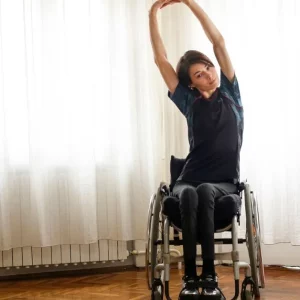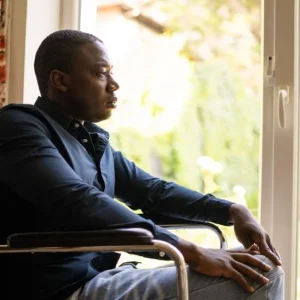One way to measure the severity of a spinal cord injury is to determine whether it is complete or incomplete. These two classifications of injury have very different recovery outlooks and rehabilitation goals. To help you understand the differences between a complete and incomplete spinal cord injury, this article will discuss:
- How to determine whether a spinal cord injury is complete or incomplete
- Recovery outlook for a complete vs. incomplete spinal cord injury
- Can an incomplete spinal cord injury be mistaken for a complete one?
- Rehabilitation goals and treatment for complete vs. incomplete spinal cord injury
How to Determine Whether a Spinal Cord Injury is Complete or Incomplete

The completeness of a spinal cord injury refers to the severity of the lesion or resulting tissue damage.
A complete spinal cord injury results in a lesion that transects across the entire spinal cord. It can occur due to a large, single lesion or multiple smaller lesions. In contrast, an incomplete spinal cord injury results in a lesion that only partially damages the spinal cord.
The spinal cord serves as the communication pathway that transmits motor and sensory messages between the brain, peripheral nerves, and muscles. However, these messages cannot pass through spinal cord lesions. As a result, motor control and sensation below the level of injury may be lost.
Because an incomplete spinal cord injury results in only partial damage, spared neural pathways exist. This allows for some communication between the brain and areas below the level of injury.
Unfortunately, because a complete spinal cord injury cuts across the entire spinal cord, there are no spared neural pathways. As a result, individuals with complete spinal cord injuries experience a complete loss of motor control and sensation below their level of injury.
In the following section, we’ll discuss how the completeness of injury affects recovery outlook.
Complete vs. Incomplete Spinal Cord Injury Recovery Outlook
Complete and incomplete spinal cord injuries have very different recovery outlooks. A unique characteristic of the central nervous system is that damaged neurons cannot regenerate and heal themselves. As a result, recovery after a spinal cord injury is highly dependent upon spared neural pathways.
This is because spared neural pathways are capable of utilizing the central nervous system’s ability to make adaptive changes and reorganize its neural circuitry called neuroplasticity. It allows for functions affected by spinal cord injury to be rewired to healthy, unaffected areas of the spinal cord.
The most effective way to activate neuroplasticity is through highly repetitive, task-specific practice. Repetition stimulates the spinal cord and reinforces demand for that function. This encourages spared neural pathways in the spinal cord to adapt.
Because only spared neural pathways are capable of utilizing neuroplasticity, only individuals with incomplete SCIs have the potential to regain motor control and sensation below the level of injury. While a complete spinal cord injury will not result in any spared neural pathways, there are treatments in progress that suggest a hopeful future for recovery of motor and sensory functions after a complete SCI.
The following section will discuss how an incomplete spinal cord injury may initially appear to be complete.
Is it Possible to Mistake an Incomplete SCI for a Complete One?
Inflammation and other secondary complications can often make the outcomes of a spinal cord injury appear worse than they actually are.
Immediately after a spinal cord injury, a process called spinal shock may occur. Spinal shock describes the complete loss of reflexes, movement, and sensation below the level of spinal cord injury. It’s caused by biochemical processes that occur after an SCI and result in oxidation, swelling, and cell deaths.
Swelling of the spinal cord restricts blood flow, resulting in the loss of spinal reflexes below the level of injury. Fortunately, spinal shock is a temporary condition that lasts anywhere between a few days to a few months. Reflexes can gradually start to return as swelling dies down and blood flow is restored.
However, during spinal shock, many patients mistake the temporary loss of movement for that of complete spinal cord injuries. It’s only after spinal shock has subsided that individuals may discover their spinal cord injury isn’t as severe as it initially appeared. To minimize swelling and reduce the chances of experiencing spinal shock, it is critical to seek immediate medical treatment after spinal cord injury.
Up next, we’ll discuss rehabilitation goals and treatment for complete and incomplete spinal cord injuries.
Complete vs Incomplete Spinal Cord Injury Rehabilitation Goals

Currently, there is no cure to reverse the damage caused by a spinal cord injury. However, individuals with incomplete injuries can utilize neuroplasticity to encourage the central nervous system to rewire itself and improve impaired functions. Likewise, individuals with complete injuries can learn adaptive techniques to become as functional as possible and prevent the progression of secondary complications.
Treatment for both complete and incomplete spinal cord injury consists of stabilization and rehabilitation. Medical stabilization focuses on minimizing spinal cord swelling, cell deaths, and inflammation. This is essential for minimizing overall damage to the spinal cord and preserving as much function as possible.
After stabilization, treatment will focus on rehabilitation to maximize functional abilities. Specialists will determine how much motor and sensory function is preserved and create a personalized rehabilitation plan to help patients adjust to their new abilities while optimizing mobility and functional independence after SCI. Early and intensive participation in rehabilitation promotes neuroplasticity and generally results in the best recovery outcomes.
Rehabilitative treatments for complete and incomplete spinal cord injury include:
- Physical therapy focuses on improving mobility through targeted exercises
- Occupational therapy helps individuals maximize their functional independence by practicing activities of daily living
- Orthotics are wearable devices that provide musculoskeletal support
- Electric stimulation involves stimulating the nerves with electrical currents that mimic brain signals
- Psychotherapy helps individuals cope with the emotional and psychological challenges of SCI
Every spinal cord injury (complete or incomplete) is unique and will require personalized treatment.
Complete vs. Incomplete Spinal Cord Injuries: Key Points
Complete and incomplete spinal cord injuries have different functional outcomes and prognoses; however, there are ways to manage the challenges of either type of SCI and significantly improve your quality of life.
Recovery after incomplete spinal cord injuries is highly dependent upon spared neural pathways and their ability to utilize neuroplasticity to make adaptive changes.
Although the recovery outlook for complete spinal cord injuries is limited, individuals can learn to utilize unaffected body parts to compensate for affected ones and be as functional as possible.
We hope this article helped you understand the differences between a complete and incomplete spinal cord injury.











